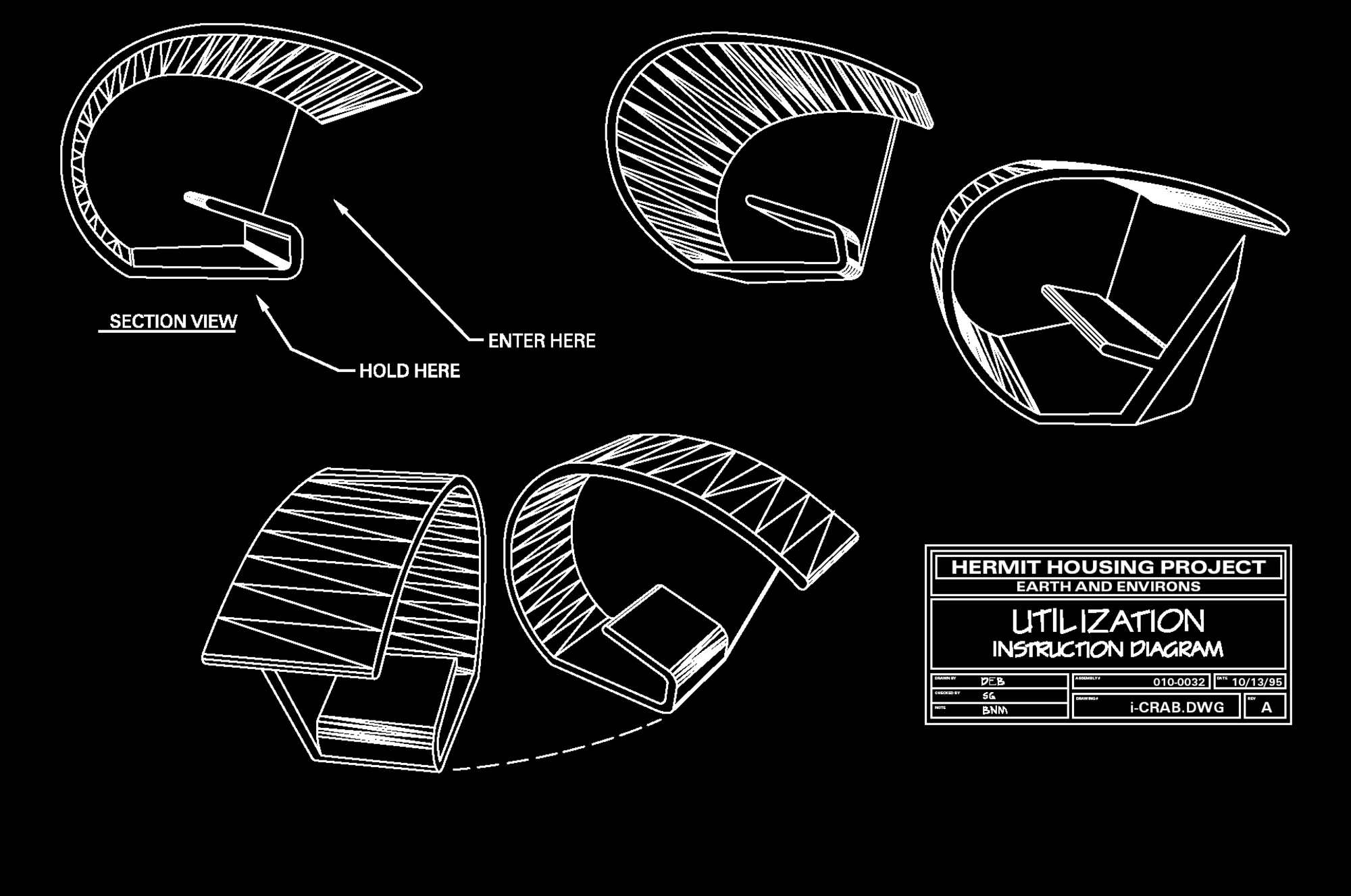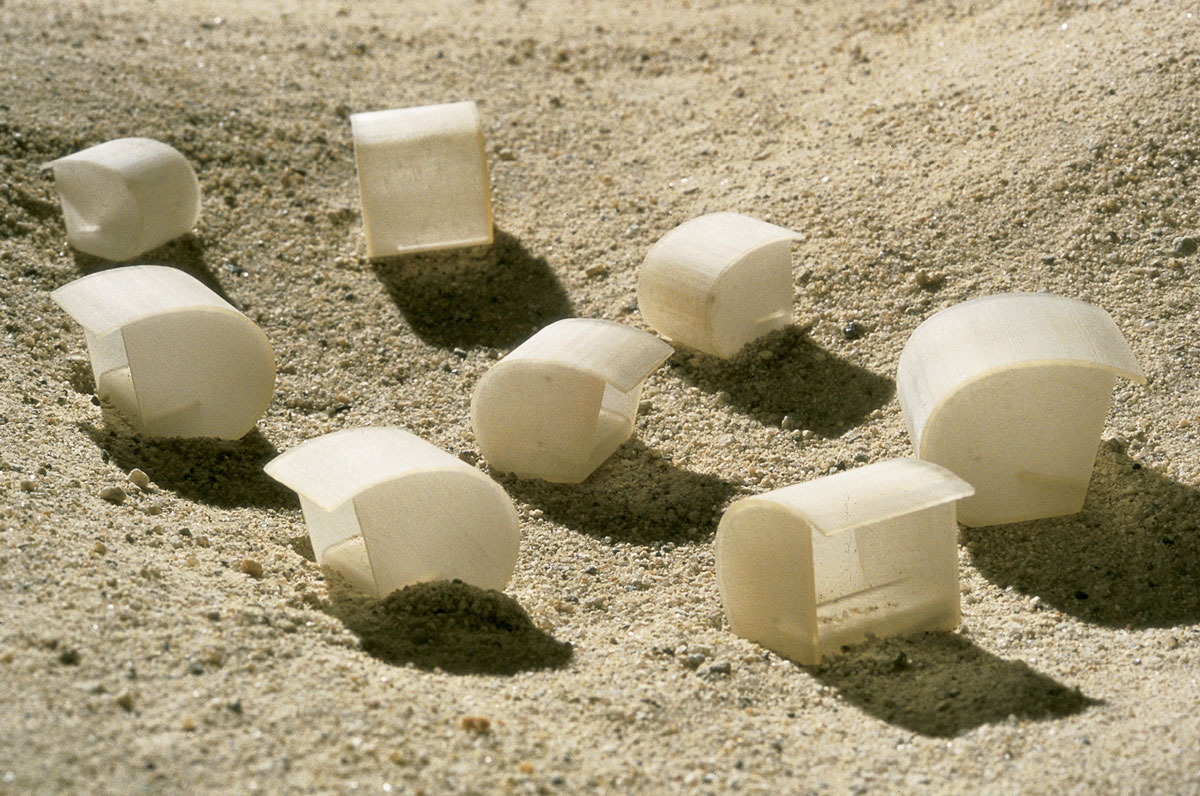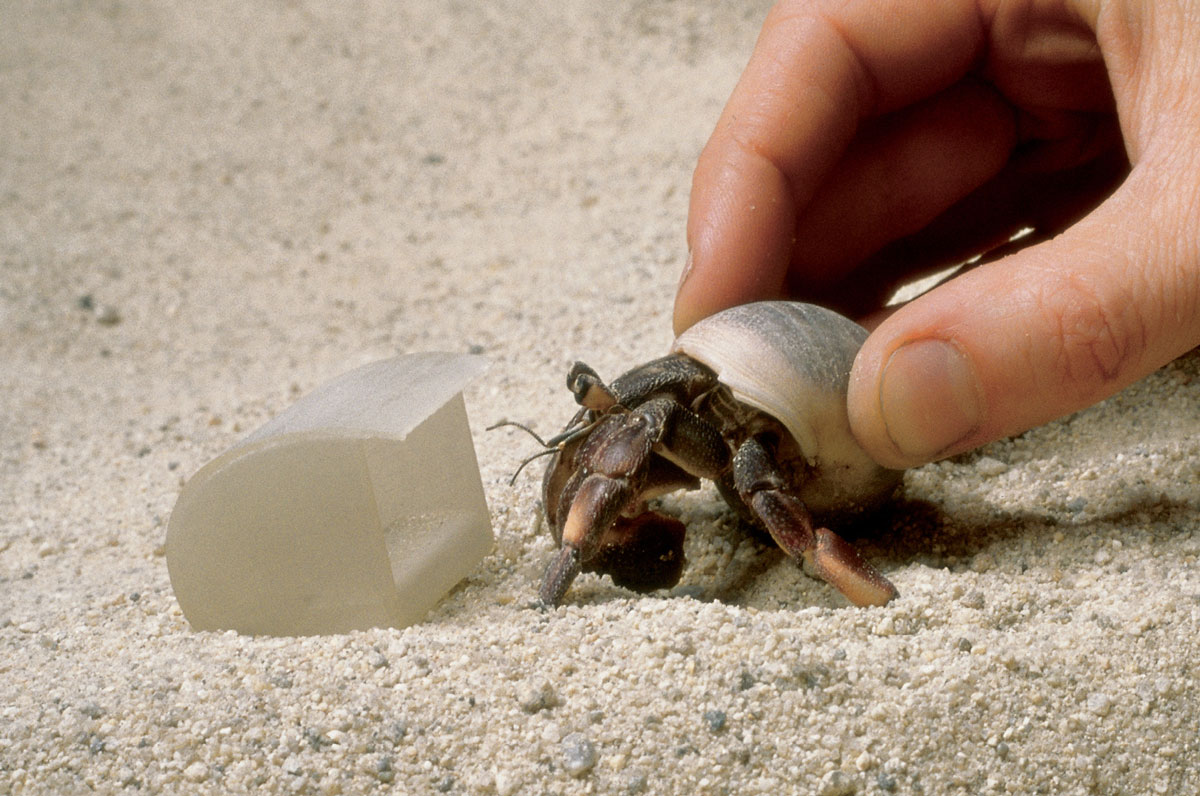The Hand Up Project: Attempting to Meet the New Needs of Natural Life-Forms
A new home for the hermit crab
Elizabeth Demaray
Right now, 30 percent of all hermit crabs on our shorelines are living in shells that are too small for them. In the springtime, when the animal has its growth spurt, this shortage skyrockets to 60 percent. Hermit crabs, whose own bodies provide only thin exoskeletons, must scavenge and appropriate hard-walled shells abandoned by marine gastropods for shelter. The problem is that there currently are not enough shells left on our beaches for hermit crabs to use. This situation is not only uncomfortable but dire. Marine hermit crabs depend upon properly fitting shells for protection from predators (Hazlett, 1981), mating success (Hazlett, 1989) and reproduction (Childress, 1972). The present lack of housing is so severe that biologists now routinely find land hermit crabs attempting to shelter themselves in glass jars and whatever other ill-fitting forms of refuse they may find at their immediate disposal.

The reason for this housing shortage is generally assumed to be pollution and the collection of seashells by humans. However, because scientists have a difficult time asserting causal relationships in uncontrolled (that is, natural) models, we are unable to state specifically all the causes of this lack. On the other hand, due to the fact that hermit crabs exhibit choosing behavior in relation to selecting shelters, this population has been studied extensively. In controlled situations that offer ample housing, biologists have been able to identify the exact features that crabs find most desirable when they are assessing and selecting dwellings.
The shells that hermit crabs seek are made by marine gastropods that secrete calcium carbonate from their mantel—the organ that covers their soft bodies. The shell is built up in deposits until the calcium carbonate becomes a crystalline structure held together via thin membranes of organic material. Depending upon the crystalline structure and the type of animal making it, the shell differentiates into numerous forms. The univalve-type shells that hermit crabs prefer to adopt are spiral in shape. The marine gastropods that make these shells form them in layered bands. These bands build a cavity that spirals from the shell’s small center to successively larger areas of internal volume at the periphery. This formation affords the growing gastropod within the hard shell an ever-increasing area in which to expand.
Hermit crabs are scavengers and often locate these borrowed dwellings by smell, when the original gastropod inhabitant dies and begins to decay. Once a hermit crab adopts a shell, it will keep it until the shell is outgrown, carrying it continuously as a shield, wherever it goes. This is no easy feat, considering that a properly fitting shell must be larger than the hermit crab that wears it, and will often significantly outweigh the crab itself. In order to carry its home, one of the crab’s front claws is completely dedicated to clutching the shell. This claw bends backward and holds on to the spool of calcium carbonate at the shell’s center. In order to move, the animal must first use this claw to lift the shell and heave it onto its back. In spite of such difficulties, the drive to remain housed is so strong in this species that a typical hermit crab would rather be torn limb from limb than be pulled out of its shell. The only time that the animal will willingly leave its shell is a) if it locates another, more suitable one, or b) if it is shedding its exoskeleton—a process which can only be accomplished by fully exiting its dwelling just long enough to wriggle out of its own exfoliated shell casing.
When a hermit crab that has grown too large for its current home locates a new one, it determines the structure’s suitability via a process called fondling. During this activity, the hermit crab will explore the shell’s surface and its internal volume-to-weight ratio by rolling the shell over and gently rocking it back and forth. Since hermit crabs actually choose the shells that they inhabit, there is a large body of information concerning shell selection. It has been shown that there is a specific volume-to-weight ratio that crabs like. Shells with a high internal volume-to-weight ratio are the most in demand. These more desirable shells facilitate growth by providing the crabs ample space in which to physically expand, while saving locomotive energy by being light in weight.
As might be imagined, even without the current housing shortage, the finding and exchanging of shells is a preoccupation amongst this species. Hermit crabs routinely take over shells that have been vacated by their fellows. Periodically, multiple crabs will locate a single new shell by smell simultaneously. When this occurs, a choreographed activity may take place. The crabs line up next to each other, according to size, with the largest situated next to the new, recently fondled dwelling. The largest crab will then vacate its shell in favor of the new one. The shell that has just been emptied will be passed to the crab next in size down the line. This crab will look it over and possibly adopt it, in turn handing its own shell down to the crab next in size, and so on. The practice is precise and fast, resulting in the greatest number of crabs achieving properly fitting homes while affording all the least amount of time spent outside their shells, unsheltered from predators.

Based on what we know about the new needs of these animals in their current environment, the Hand Up Project proposes to manufacture alternative forms of housing, specifically designed for use by land hermit crabs, out of plastic. This solution offers multiple benefits. Not only will the project afford the animal badly needed additional forms of shelter, but we also contend that, by utilizing current technology, we may now be better equipped to meet the needs of this life-form than nature ever has.
The use of plastic in manufacturing these new homes is key. This material affords the crab an almost ideal dwelling. Being much lighter than calcium carbonate, these new houses do not take as much energy to carry during locomotion. Plastic is also structurally strong, which affords large areas of internal space in the new structures. This results in the greater internal volume-to-weight ratio that the crab prefers. Of additional benefit is the longevity of this material coupled with the way these crabs recycle and share their shelters. Due to the fact that plastic is non-biodegradable, these new forms may potentially outlast the life-span of the crab itself, thereby assuring many generations access to additional hand-me-down housing.
We acknowledge that such trans-species caregiving may in fact be a form of control. In recognition of this paradox, the new structures are aesthetically based on the architecture of Giuseppe Terragni, an Italian Fascist active in the 1930s. Physically, the design of the new forms has been tailored to the animal’s needs. The structures are offered for various body sizes. The shell spiral in the middle has been eliminated, reducing the overall weight of each house and increasing its internal volume. Instead of this central core, the new design offers an internal flange attached to the front opening for the crab to clutch with its holding claw. Shelter while foraging has also been considered. Similar to the hood-like structure found in a traditional shell, the new form offers an overhang for additional protection in situations where the body must be extended outside the dwelling. Color can also be adapted to the needs of the animal. The prototype houses are tinted beige, which affords the wearer maximum camouflage on many of the beaches in North America. The color can, however, be visually matched to a specific population’s native environment for optimal protection.
In its beta version, the Hand Up Project was a great success. Twenty-five percent of the initial crab population chose to move into a new, fabricated home when presented with the novel structures for a period of two months. The beta version involved crabs in captivity, where body growth is more gradual and, consequently, shell exchange occurs less frequently. Due to this fact, there is reason to believe that, in the wild, where growth is more rapid, these numbers will be even better.

This first generation of houses was produced using rapid prototyping. The design was drawn in AutoCAD. Each form was then created in one piece, via a stereo lithography process, where a laser deposits thin layers of plastic to create the overall structure. This procedure allowed the houses to be made without the use of separate parts, so that the new “shells” could be created without using glues or solvents that could harm the animals. These seamless structures have also proven to be quite strong. In its final version, the project will use die injection molds to manufacture the new houses. While the start-up cost is significant, this method will allow the structures to be mass-produced with few seam lines and at an enormous reduction in cost from the initial method of fabrication.
The funding needed to manufacture and distribute these shelters is significant. It is also significant that—notwithstanding the contradictions inherent in current scientific knowledge—this production is purely altruistic in its intent. The scope of the project is global, and accordingly, corporate funding has been targeted as a potential revenue source. The project is currently soliciting corporate and commercial sponsorship to fund manufacturing and distribution costs by licensing the houses for advertising. In exchange for financial support, each plastic shelter may be readily produced bearing a corporate logo. From this perspective, the longevity of these dwellings is also a plus, in that their existence will guarantee the perpetuation of advertising across a time-span best described as evolutionary.
While we recognize that this funding solution will increase the current proliferation of corporate logos on beaches and in other apparently pristine environments, we do feel that it is appropriate to utilize these insignias of global capital, and the wealth they symbolize, in the service of ameliorating environmental problems that have been caused by humans in the first place.
This effort is a minor, genuine attempt to give a struggling life form a hand up. The project maintains that innovative technological solutions can be brought to bear upon a great number of problems involving the present existence and future survival of many life forms. The intended audience of the Hand Up Project is someone who, while walking on a beach, might pause to contemplate a slowly ambulating hermit crab, wearing on its back a tiny, man-made plastic house bearing a corporate logo.
J. R. Childress, “Behavioral Ecology and Fitness Theory in a Tropical Hermit Crab,” Ecology, vol. 53 (1972), pp. 960–964.
B. A. Hazlett, “The Behavioral Ecology of Hermit Crabs,” Annual Review of Ecology and Systematics, vol. 12 (1981), pp. 1–22.
B. A. Hazlett & L. C. Baron, “Influence of Shells on Mating Behavior in the Hermit Crab Calcinus tibicen,” Behavioral Ecology and Sociobiology, vol. 24 (1989), pp. 369–376.
Elizabeth Demaray is an artist whose work explores the connection between the named world and the real. She is co-founder and co-curator of the Conceptual Art Store.com and teaches at Rutgers University at Camden where she is head of sculpture.